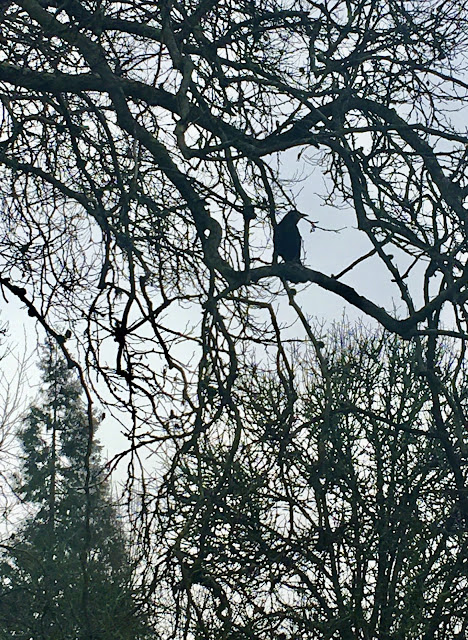- Read and Journal: I intend to learn more about the nature in my own backyard, starting with a dive into various web sites, and will also keep a daily nature journal with notes about the weather and things I notice.
 Explore resilience practices: I'm also reading from the book, "101 Mindful Ways to Build Resilience," by Donald Altman, which offers simple ideas for being more rooted in my body and mind.
Explore resilience practices: I'm also reading from the book, "101 Mindful Ways to Build Resilience," by Donald Altman, which offers simple ideas for being more rooted in my body and mind.- Take creative action: In the weeks of Lent, I intend to act on my leading to become more rooted in Creation by
- Tending my garden (and letting it tend me)
- Building habitat for plant and animal people
- Supporting and working directly on campaigns to defend the environment
- Witnessing to others with writing, talking, and artwork.
- Fast: This year, like last year, I intend to fast from all new single-use plastic, and continue to experiment with plastic alternatives. I'm also going to witness to why plastic production is so dangerous, and why we need to slow it down.
February 26, Forgiveness Sunday-
- How to choose the best birds to study, that will give you the most information without overwhelming you.
- How to find good locations to practice, including your backyard.
- How to be stealthy and not cause alarms.
- Bring the palms of your hands together in front of your chest, and notice the warmth between them for a moment or two, to get centered.
- Take a big inhale into your belly as you slowly open both arms outward.
- When arms are spread open to the max, hold your breath for a count of two.
- Then slowly release all your breath with a count of four, as you move your palms back together.
- Repeat 3-5 times.
I ask for forgiveness from those I've hurt, and I offer forgiveness to those who have hurt me - and to those who hurt the earth. In asking and offering forgiveness, I hope to be able to release this burden of shame, indignation, and fear, and move on with resilience.
- Focus on a single, simple gratitude, such as appreciation of your body, or fresh water, or a relationship that bring you joy.
- Make a point of appreciating something new each morning.
- Write each one down so you have a record.
- Mentally repeat your blessing throughout the morning, and notice how it makes you feel.
The primary function of structured caws is to keep track of other members of their flock at a distance. They sound like a short burst of 1-9 caws, all be similar in sound, volume, and intensity. Then a short pause of silence anywhere between 15 - 60 seconds. Then another burst of caws followed by another period of silence, and so on - structured and consistent, and indicating an overall emotional state of safety, relaxation and well-being.
To hear an example of this type of calling visit this webpage.
"Unstructured crow caws fluctuate in volume, pitch, frequency and overall intensity as the event gets more intense. Continuous “cawing” from multiple individuals can go on without stopping for a very long time as the crows mob the source of their excitement. If you hear these sounds coming from a group of crows, you might see other crows flying towards them at rapid speed to rally and mob an eagle or an owl."
"When you hear crows making structured vocalizations... look around for signs of “maintenance” behaviour (resting, preening, feeding, nesting, courtship)
When you hear crows making unstructured vocalizations... try to get closer and see if you can identify what’s causing the emotional intensity".
- Lower the lights, take a slow breath, put your hand over your heart.
- Think back over your day. Recall one unexpected positive event or response from another for which you are thankful, and remember little moments that you savored and appreciated.
- State your gratitude for that which this day provided.
- Send a wish for rest, peace, love, and wellness to others.
When in season, remember to buy berries and other fruits from farmers markets. Farmers often use sustainable packaging or will reuse what you bring. Freeze or can fruits when it is available seasonally, to avoid buying plastic bags of berries later.
- Start one hour before your regular bedtime. Turn off the tv, tablets, and computer, so the light from these devises doesn't interfere with the production of melatonin.
- Choose any activities that will calm you down: Take a warm bath, get into your pajamas, listen to soft music, have a hot drink, read something fun...
- Let go of thoughts about "things to do', and let your mind take a creative story journey instead.
- Take 2 or 3 soothing Breaths.
- Tune in to your Emotional state.
- Place your hands over your eyes, then your temples, then one on your forehead and one on the back of your neck, and feel the soothing Touch.
- Notice as many different and subtle sounds as you can Hear.
- Intentionally stretch your shoulders and neck.
- Notice as many Sights and Smells as you can, with child-like wonder.
Query: How do you use the resources and strength you are given to meet the challenges of living a whole and honest life?



No comments:
Post a Comment